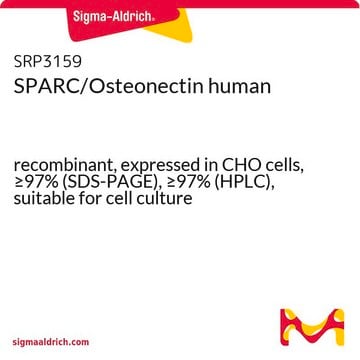STS0201
ECO TWEEN® 40
viscous liquid
Synonym(e):
TWEEN® 40, Polyoxyethylen-sorbitan-monopalmitat
About This Item
Empfohlene Produkte
Beschreibung
non-ionic
Qualitätsniveau
Assay
~90.0% (GC)
Form
viscous liquid
Mol-Gew.
estimated mol wt 1277
Zusammensetzung
Palmitic acid, ~90.0% (balance primarily stearic acid)
Grünere Alternativprodukt-Eigenschaften
Use of Renewable Feedstocks
Design for Degradation
Learn more about the Principles of Green Chemistry.
sustainability
Greener Alternative Product
CMC
0.027 (20-25°C)
Löslichkeit
water: 100 mg/mL, clear to slightly hazy, faintly yellow
HLB
15.6
Grünere Alternativprodukt-Kategorie
, Aligned
InChI
1S/C26H50O10/c1-2-3-4-5-6-7-8-9-10-11-24(30)34-19-18-31-20-22(32-15-12-27)26-25(35-17-14-29)23(21-36-26)33-16-13-28/h22-23,25-29H,2-21H2,1H3
InChIKey
HMFKFHLTUCJZJO-UHFFFAOYSA-N
Suchen Sie nach ähnlichen Produkten? Aufrufen Leitfaden zum Produktvergleich
Allgemeine Beschreibung
Anwendung
Leistungsmerkmale und Vorteile
- 100 % Renewable
- 100 % Bio-based
- Certified to the USDA BioPreferred Program
- Lower carbon footprint than petrochemical-based versions
- High-purity chemical suitable for a wide variety of research applications
Sonstige Hinweise
Rechtliche Hinweise
Lagerklassenschlüssel
10 - Combustible liquids
WGK
WGK 1
Choose from one of the most recent versions:
Analysenzertifikate (COA)
Don't see the Right Version?
If you require a particular version, you can look up a specific certificate by the Lot or Batch number.
Besitzen Sie dieses Produkt bereits?
In der Dokumentenbibliothek finden Sie die Dokumentation zu den Produkten, die Sie kürzlich erworben haben.
Unser Team von Wissenschaftlern verfügt über Erfahrung in allen Forschungsbereichen einschließlich Life Science, Materialwissenschaften, chemischer Synthese, Chromatographie, Analytik und vielen mehr..
Setzen Sie sich mit dem technischen Dienst in Verbindung.







